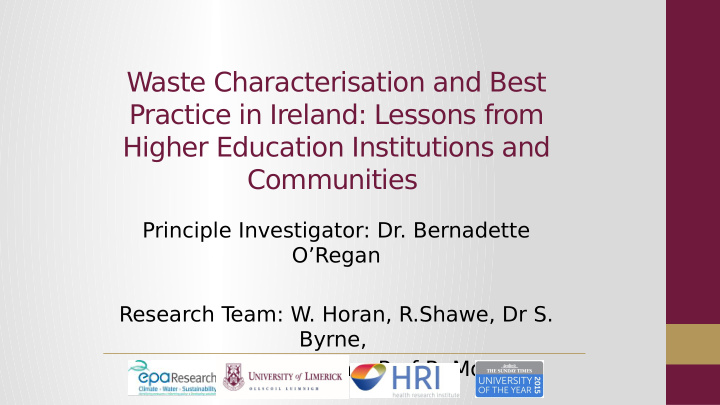



Waste Characterisation and Best Practice in Ireland: Lessons from Higher Education Institutions and Communities Principle Investigator: Dr. Bernadette O’Regan Research T eam: W. Horan, R.Shawe, Dr S. Byrne, A. Bennett, R. Byrne, Prof R. Moles.
Funding Acknowledgement The Sustainability Pillar of the EPA’s Research Programme 2014-2020 is designed to identify pressures, inform policy and develop solutions to environmental challenges within thematic areas through the provision of strong evidence- based scientifjc knowledge.
National Municipal Waste Context
Municipal Waste In Ireland 2014 41,43% Household 58,57%
Municipal waste recycled, used as a fuel and disposed to landfjll EPA (2019)
Circular Economy
Concerns Surrounding Waste Recycling Internationally • China bans importation of mixed/contaminated wastes • Southeast Asian countries serving as dumping ground for eg EU/USA waste (but likely to stop very soon) • 2019 Philippines sends contaminated “recycling waste” back to Canada
HEI Municipal Solid Waste: Non- household
Limited Data Collection at Irish HEIs
Irish HEI Waste CO 2e Emissions
Comprehensive Data Collection at UK HEIs tied to Funding HESA (2017)
Packaging of RTU Infant Formula Milk
Exemplifjes the big problems with plastic recycling • Packaging uses a range of materials, not easily separated • Diffjcult to identify polymers in many of the components • Very small amounts of some materials makes collection unfeasible • Danger of contamination by residual milk
Lessons for Non-Household Waste Reduction • Provision of segregated waste bins becoming norm- Trials at UL, UCC, LIT • Currently no standardised waste bin segregation signage adopted by entire HEI sector • Awareness campaigns surrounding benefjts of re-usable cofgee cups- DCU, UCC • Compostable cofgee cups- Benefjts lost without dedicated compostable bin • Aspirations for plastic free universities- Debate on what plastics should be included
Community Municipal Solid Waste: Household
EPA Household Waste Characterisation Survey 2018 EPA (2018)
EPA Household Waste Characterisation Survey 2018
Main Findings from Irish Household Waste Characterisation Surveys 2018 • There has been a signifjcant reduction in organic waste in the household residual bin, thanks to the introduction of the brown bin. • Approximately 50% of household organic waste is still being disposed of in the “wrong bins”, i.e. recycling or residual bin. • Plastics have replaced organic waste as the most prominent waste category in mixed residual household waste. • 11% of the household waste shouldn’t be in the kerbside bins at all. This material is largely made up of T extiles, Glass and Hazardous waste such as paint, WEEE and batteries.
Actions for Waste Reduction • Upcycling of Waste Clothing- Ballymun Rediscovery Centre • Zero Waste Cashel- plastic free areas (Schools), plastic straw awareness campaigns, water refjll stations in community • Community Composting- Greener Clare Programme collaboration with EPA Stop Food Waste
EPA Projects • O’Regan, B., Moles, R., Shawe, R. and Horan, W. (2019) ‘Developing the Potential of Third Level Campuses as Change Agents in Transition to Sustainable Communities’, Prepared for the Environmental Protection Agency , Ireland. • Byrne, S and O’Regan, B. (2019) ‘Developing the Potential of Community Energy Action Groups T owards Transition to a Low Carbon Society’, Prepared for the Environmental Protection Agency , Ireland. • O’Regan, B., Moles, R., Byrne, R and Bennett, A. (2019) ‘Sustainable Voluntary Communities: Supports for Sustainable Environmental, Social and Economic Development’, Prepared for the Environmental Protection Agency , Ireland. • O’Regan, B., Moles, R., Shawe, R. and Ryan-Fogarty, Y . (2019) ‘Developing Frameworks for Evaluation and Mitigation of Environmental Impact of Infant Feeding Decisions on Healthcare and Society’, Prepared for the Environmental Protection Agency, Ireland.
Contact: Dr Bernadette O’Regan Senior Lecturer in Environmental Science University of Limerick Ireland bernadette.oregan@ul.ie
Funding Acknowledgement The Sustainability Pillar of the EPA’s Research Programme 2014-2020 is designed to identify pressures, inform policy and develop solutions to environmental challenges within thematic areas through the provision of strong evidence- based scientifjc knowledge.
Recommend
More recommend